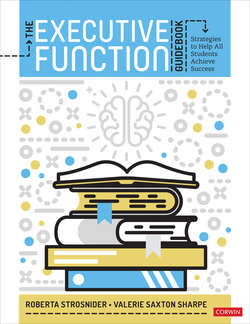Читать книгу The Executive Function Guidebook - Roberta Strosnider - Страница 22
На сайте Литреса книга снята с продажи.
Examining Each of the 7-Steps in Detail for an Individual or Small Group Step 1 Determine the student’s EF deficits and note them in the Executive Function (EF) Planning Chart. Assessment
ОглавлениеThis is completed through reviewing the student’s records as well as through observations of the student and interviews with the student, as well as his or her family members and other and previous teachers. Formal and informal assessments may also be used to help determine EF deficits. While there is no federal mandate to assess executive functioning and no preferred battery of tests to determine that a student has deficits in certain executive function skills, formal assessments used in the diagnosis of a disability under IDEA often include relevant information and are offered at no cost to the parents (Tucker, 2015). Other formal assessments such as the BRIEF (Gioia, Isquith, Guy, & Kenworthy, 2013), or parts of formal assessments, provide additional information that is helpful in determining areas of weakness and the best way of meeting the student’s needs. Neuropsychologists, school psychologists, or speech pathologists usually administer formal assessments. Informal assessment may include questionnaires, surveys, and observations. When questionnaires are used, it is important to get the opinions of the student, the parents, and the teacher(s). Structured interviews, such as the instrument Executive Functioning Semi-Structured Interview developed by Kaufman (2010), can be used to gain information regarding a student’s executive functioning strengths and needs through interviews with the student, teachers, and parents. Included in Appendix 1.15 is a Sample Student Self-Assesment Tool you can use or revise to meet the needs of your particular situation. It provides actions for students to self-rate themselves and a column for teacher validation and comments.
Having reviewed the above information, consider how the student’s strengths and difficulties are exhibited in terms of academic, communicative, and social/emotional behaviors. Determine whether the student has deficits in any of the following executive function areas:
Working Memory
Prioritizing, Organizing, Sequencing, Managing Time, and Planning
Attending, Focusing, and Initiating
Controlling Social/Emotional Behaviors, Inhibiting Behaviors
Communicating, Cognitive Flexibility/Shifting
Determine from all of the information collected how the executive function difficulty presents. What behaviors does the learner exhibit that provide evidence of an executive function difficulty? Match the student’s EF skill area personalizing what the EF difficulty looks like for the student(s).
An Executive Function Planning Chart, such as the one shown in table 1.5, may be used in this step.
